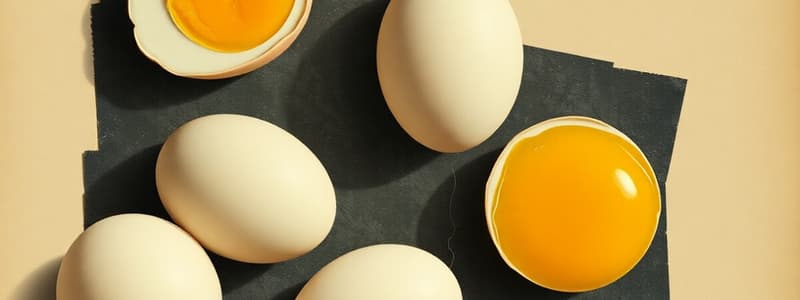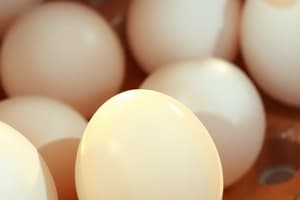Podcast
Questions and Answers
What is the desired texture for a properly cooked omelette?
What is the desired texture for a properly cooked omelette?
- Hard outside, soft inside (correct)
- Fluffy but dry
- Runny inside and hard outside
- Soft throughout
Which of the following describes a Spanish omelette?
Which of the following describes a Spanish omelette?
- Folded and served in a crescent shape
- Open-faced and topped with diced potatoes and peppers (correct)
- Stuffed with various ingredients
- Cooked quickly over high heat
What should never be used in egg preparations due to potential allergies?
What should never be used in egg preparations due to potential allergies?
- Chili flakes
- Oregano
- Salt
- Black peppercorn powder (correct)
Which component is typically included with eggs in breakfast service?
Which component is typically included with eggs in breakfast service?
How is scrambled egg prepared to achieve its texture?
How is scrambled egg prepared to achieve its texture?
What is the typical number of eggs served in one portion unless requested otherwise?
What is the typical number of eggs served in one portion unless requested otherwise?
What is a common characteristic of a plain omelette?
What is a common characteristic of a plain omelette?
What gas is primarily responsible for the off odours in aging eggs?
What gas is primarily responsible for the off odours in aging eggs?
What is Akuri or Akoori?
What is Akuri or Akoori?
What causes the formation of the black ring in hard boiled eggs?
What causes the formation of the black ring in hard boiled eggs?
What is the coagulation temperature range for the whole egg?
What is the coagulation temperature range for the whole egg?
How does the presence of added materials like sugar affect egg coagulation?
How does the presence of added materials like sugar affect egg coagulation?
What is one of the uses of eggs as a leavening agent?
What is one of the uses of eggs as a leavening agent?
What is the main benefit of cooking eggs at a lower temperature for a longer time?
What is the main benefit of cooking eggs at a lower temperature for a longer time?
Which vitamin is NOT typically found in eggs?
Which vitamin is NOT typically found in eggs?
Which of the following is NOT a role of eggs in cooking?
Which of the following is NOT a role of eggs in cooking?
What is Egg Bhurji known for?
What is Egg Bhurji known for?
Which type of egg is considered the second most popular variety?
Which type of egg is considered the second most popular variety?
Which grade of egg quality indicates clean shells and smooth egg whites?
Which grade of egg quality indicates clean shells and smooth egg whites?
How are eggs typically stored for daily use?
How are eggs typically stored for daily use?
Which of the following eggs is the largest in size?
Which of the following eggs is the largest in size?
What should be done with thawed frozen eggs?
What should be done with thawed frozen eggs?
Which quality indicates that the yolk is fairly centered?
Which quality indicates that the yolk is fairly centered?
What is the primary method of cooking for a hard boiled egg?
What is the primary method of cooking for a hard boiled egg?
Which type of eggs have the highest fat content compared to others?
Which type of eggs have the highest fat content compared to others?
Which egg preparation involves breaking the egg into simmering water?
Which egg preparation involves breaking the egg into simmering water?
What characteristic distinguishes a sunny side up egg?
What characteristic distinguishes a sunny side up egg?
Which style allows the yolk to harden along with the egg white?
Which style allows the yolk to harden along with the egg white?
How long is a soft boiled egg typically cooked?
How long is a soft boiled egg typically cooked?
Which addition helps the egg white to coagulate faster in poached eggs?
Which addition helps the egg white to coagulate faster in poached eggs?
What is the main purpose of frying an egg?
What is the main purpose of frying an egg?
What would happen if a poached egg is cooked for too long?
What would happen if a poached egg is cooked for too long?
What determines the color of an eggshell?
What determines the color of an eggshell?
What is the term for the velvety appearance of a fresh egg's shell?
What is the term for the velvety appearance of a fresh egg's shell?
What happens to the inner air cell of a fresh egg when it is broken?
What happens to the inner air cell of a fresh egg when it is broken?
Which change occurs in the egg white as it ages?
Which change occurs in the egg white as it ages?
What effect does aging have on the yolk of an egg?
What effect does aging have on the yolk of an egg?
How does the protective mucous covering of an egg shell change as the egg deteriorates?
How does the protective mucous covering of an egg shell change as the egg deteriorates?
What causes an aging egg to lose weight?
What causes an aging egg to lose weight?
What condition can occur if the vitellin membrane of the yolk weakens?
What condition can occur if the vitellin membrane of the yolk weakens?
Flashcards
Egg Shell Bloom
Egg Shell Bloom
The delicate, velvety appearance on a fresh egg shell caused by a protective mucous coating. This coating helps prevent bacteria from entering the egg.
Fresh Egg Air Cell
Fresh Egg Air Cell
The small air pocket located between the inner and outer shell membranes of a fresh egg.
Thick vs. Thin Egg White
Thick vs. Thin Egg White
The egg white has two layers - thick and thin. The thick white is firm and jelly-like, while the thin white is more watery.
Egg Yolk Color
Egg Yolk Color
Signup and view all the flashcards
Egg Deterioration
Egg Deterioration
Signup and view all the flashcards
Why does an egg's air cell get bigger?
Why does an egg's air cell get bigger?
Signup and view all the flashcards
What changes happen to the egg white during aging?
What changes happen to the egg white during aging?
Signup and view all the flashcards
What happens to the egg yolk during aging?
What happens to the egg yolk during aging?
Signup and view all the flashcards
Off Odours in Eggs
Off Odours in Eggs
Signup and view all the flashcards
Black Ring in Hard Boiled Eggs
Black Ring in Hard Boiled Eggs
Signup and view all the flashcards
How to Avoid Black Ring
How to Avoid Black Ring
Signup and view all the flashcards
Heat Coagulation
Heat Coagulation
Signup and view all the flashcards
Factors Affecting Coagulation
Factors Affecting Coagulation
Signup and view all the flashcards
Uses of Eggs: Leavening
Uses of Eggs: Leavening
Signup and view all the flashcards
Uses of Eggs: Binding
Uses of Eggs: Binding
Signup and view all the flashcards
Uses of Eggs: Nutritional Benefits
Uses of Eggs: Nutritional Benefits
Signup and view all the flashcards
Boiled Egg
Boiled Egg
Signup and view all the flashcards
Hard Boiled Egg
Hard Boiled Egg
Signup and view all the flashcards
Soft Boiled Egg
Soft Boiled Egg
Signup and view all the flashcards
Poached Egg
Poached Egg
Signup and view all the flashcards
Fried Egg
Fried Egg
Signup and view all the flashcards
Sunny Side Up
Sunny Side Up
Signup and view all the flashcards
Over Easy
Over Easy
Signup and view all the flashcards
Well Done
Well Done
Signup and view all the flashcards
Omelette Technique
Omelette Technique
Signup and view all the flashcards
Plain Omelette
Plain Omelette
Signup and view all the flashcards
Stuffed Omelette Variations
Stuffed Omelette Variations
Signup and view all the flashcards
Spanish Omelette
Spanish Omelette
Signup and view all the flashcards
Scrambled Egg Technique
Scrambled Egg Technique
Signup and view all the flashcards
Scrambled Egg Serving Tip
Scrambled Egg Serving Tip
Signup and view all the flashcards
Pepper in Egg Dishes
Pepper in Egg Dishes
Signup and view all the flashcards
Egg Serving Size
Egg Serving Size
Signup and view all the flashcards
Egg Bhurji
Egg Bhurji
Signup and view all the flashcards
Chicken Egg Varieties
Chicken Egg Varieties
Signup and view all the flashcards
Turkey Eggs
Turkey Eggs
Signup and view all the flashcards
Guinea Fowl Eggs
Guinea Fowl Eggs
Signup and view all the flashcards
Duck Eggs
Duck Eggs
Signup and view all the flashcards
Geese Eggs
Geese Eggs
Signup and view all the flashcards
Ostrich Eggs
Ostrich Eggs
Signup and view all the flashcards
Quail Eggs
Quail Eggs
Signup and view all the flashcards
Study Notes
Egg Characteristics
- Color of the shell varies, white or brown, depending on the hen breed
- Fresh eggs have a delicate velvety texture ("bloom") from a protective mucous coating
- Fresh eggs have a small air cell
- Yolk color ranges from golden to light yellow, depending on carotenoid pigments
- Egg white is colorless or slightly opalescent
- No strong odor, and excellent flavor when cooked
Egg Structure
- Chalaza (cord)
- Air cell
- Shell membranes
- Germinal disc
- Yolk
- Vitelline membrane
- Thick albumen (white)
- Thin albumen (white)
Egg Deterioration
- Changes begin as soon as the egg is laid.
- Store eggs under suitable conditions.
- Mucous coating disappears, shell becomes shiny and porous
- Loss of weight and contraction of contents due to carbon dioxide and moisture
- Air space between membranes enlarges
- Egg white loses its consistency, becomes watery, and drains away from the yolk
Egg Cooking/Coagulation
- Heat causes protein coagulation in eggs.
- Cooking temperatures and time affect coagulation rate and firmness of the gel.
- Whole eggs coagulate at 57°C-66°C (135°F-150°F).
- Egg whites coagulate at 58°C-62°C (136°F-144°F).
- Higher temperatures result in faster, firmer coagulation.
- Longer cooking times at lower temps results in more nourishing and flavorful eggs.
Egg Uses
- Leavening agent (soufflés, meringues)
- Binding agent (croquettes)
- Nutritious (proteins, Vitamins A, D, B-complex)
- Decoration & garnishing
Popular Breakfast Egg Preparations
- Boiled eggs (hard-boiled, soft-boiled)
- Poached eggs
- Fried eggs (sunny-side up, over easy, well-done)
- Omelettes (plain, stuffed, Spanish)
- Scrambled eggs
Egg Varieties
- Chicken eggs (most common)
- Turkey eggs
- Guinea fowl eggs
- Duck eggs
- Goose eggs
- Ostrich eggs
- Quail eggs
Egg Grades
- AA (clean, no cracks, clear white, round yolk)
- A (fairly clean, no cracks, fairly clear white, fairly centered yolk)
- B (slightly strained, loose albumin, off-centered or flattened yolk)
- C (moderately strained, very loose albumin, very flat or broken yolk)
Egg Storage
- Refrigerate eggs in a stable holder to prevent breaking.
- Store eggs pointed end down.
- Avoid storing eggs next to strong-smelling foods, as eggs absorb odors.
- Use fresh eggs within a few weeks
Studying That Suits You
Use AI to generate personalized quizzes and flashcards to suit your learning preferences.





